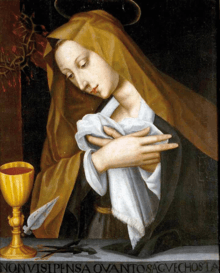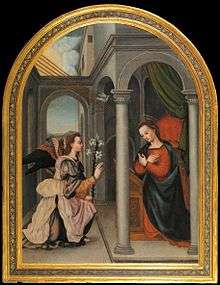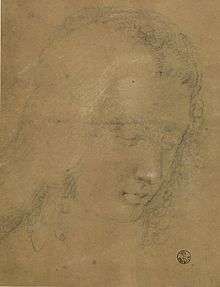Plautilla Nelli
Sister Plautilla Nelli (1524–1588) was a self-taught nun-artist and the first-known female Renaissance painter of Florence, Italy.[1] She was a nun of the Dominican convent of St. Catherine of Siena located in Piazza San Marco, Florence, and was heavily influenced by the teachings of Savonarola and by the artwork of Fra Bartolomeo.[1]









Life
Pulisena Margherita Nelli was born into a wealthy family in Florence, Italy. Her father, Piero di Luca Nelli, was a successful fabric merchant and her ancestors originated from the Tuscan valley area of Mugello, as did the Medici dynasty.[1] There is a modern-day street in Florence, Via del Canto de’ Nelli, in the San Lorenzo district, named for her family, and the New Sacristy of the Church of San Lorenzo is the original site of her family homes.[1]
She became a nun at the age of fourteen, taking on the name Suor Plautilla. Nelli's convent of Santa Caterina da Siena, of which she was prioress three times, was managed by the Dominican friars of San Marco, led by Savonarola. Savonarola's preachings promoted devotional painting and drawing by religious women to avoid sloth, thus the convent became a center for nun-artists.[1] Her sister, also a nun, Costanza, (Suor Petronilla) wrote a life of Savonarola.
Nelli enjoyed the esteemed favor of many patrons (including women), executing large pieces and miniatures. Sixteenth-century art historian Giorgio Vasari wrote, “and in the houses of gentlemen throughout Florence, there are so many pictures, that it would be tedious to attempt to speak of them all."[2] Fra' Serafino Razzi, a sixteenth-century Dominican Friar, historian and Savonaroliano (disciple of Savonarola), named three nuns of Santa Caterina as disciples of Plautilla, Suor Prudenza Cambi, Suor Agata Trabalesi, Suor Maria Ruggieri, and three others as additional producers: Suor Veronica, Suor Dionisia Niccolini, and his sister Suor Maria Angelica Razzi.
Art and style
Though she was self-taught, Nelli copied works of the mannerist painter Agnolo Bronzino and high Renaissance painter Andrea del Sarto. Her primary source of inspiration came from copying works of Fra Bartolomeo, which mirrored the classicism-style enforced by Savonarola's artistic theories. Fra Bartolomeo left his drawings to his pupil, Fra Paolino who, in turn left them in the possession of "a nun who paints"[1] in the convent of Santa Caterina da Siena.[1]
Nelli's work is distinguished from that of her influencers by the heightened sentiment she adds to each of her characters' expressions.[3] Author Dr. Jane Fortune referred to her Lamentation with Saints and the “raw emotional grief surrounding Christ’s death as depicted through the red eyes and visible tears of its female figures” as a case in point.[1] Most of Nelli’s works are large-scale, which was most uncommon for a woman to paint, during her time period.[4]
Nelli is one of the few female artists mentioned in Vasari's Lives of the Most Excellent Painters, Sculptors and Architects.[5] Nelli's work is characterized by religious themes, with vivid portrayals of emotion on her characters' faces. Nelli lacked any formal training and her male figures are said to have “feminine characteristics”, as her religious vocation prohibited study of the nude male.[6]
Works created, rediscovered, and restored
Nelli produced mainly devotional pieces including large-scale paintings, wood lunettes, book illustrations, and drawings. Her paintings include Lamentation with Saints (in the large refectory, San Marco Museum, restored 2006), Saint Catherine Receives the Stigmata and Saint Dominic Receives the Rosary, in the Andrea del Sarto Last Supper Museum of San Salvi, both restored in 2008.[7] Nelli’s Grieving Madonna, also at San Salvi, is a copy of the same subject by Alessandro Allori.[3] Her Crucifixion is exhibited in the Certosa di Galluzzo Monastery, near Florence. The Last Supper, in the refectory of Santa Maria Novella (not open to the public), is the only work Nelli signed.[3] Her nine drawings in the Uffizi’s Department of prints and Drawings were restored in 2007 and include several representations of the human figure such as Bust of a Young Woman, Head of a Youth, Kneeling Male Figure.[6] The Pentecost, in Perugia’s Basilica of San Domenico, is another of her most significant works, as well as her Annunciation and St. Catherine of Siena both preserved at the Uffizi.

Plautilla Nelli’s Last Supper is a first in the history of art by women. No woman artist ever painted this subject before Nelli. Florence has the richest tradition of paintings with theme of last supper in the world. Nelli’s Last Supper is now under restoration (to be completed in 2018), her most significant work because of its size and subject, a seven-meter long, oil on canvas. After restoration her Last Supper will be exhibited at the Santa Maria Novella Museum in Florence across from Alessandro Allori’s painting with the same theme, also painted in the sixteenth century. Nelli’s work represents a daring creative endeavor for a nun-artist of her period, as most were relegated to producing miniatures, textiles or small sculptures in painted terra cotta or wood. By creating and signing this enormous fresco like work depicting one of Florence’s most loved spiritual subjects, Nelli successfully placed herself among the ranks of her male counterparts, such as Leonardo Da Vinci, Andrea del Sarto and Domenico Ghirlandaio, an accomplishment lost to history until recently.
Exhibits
- "Sister Plautilla Nelli. Convent Art and Devotion in the Footsteps of Savonarola" exhibit, curated by Dr. Fausta Navarro, Uffizi, Florence, 9 March-4 June 2017.
Documentary
The Restoration of Lamentation with Saints: Plautilla Nelli is a thirty-six-minute documentary[3] on the life of Florence's first-known female painter, Plautilla Nelli[6] and on the process of restoring of one of her most significant large-scale paintings. The documentary, produced in 2007 by Art Media Studio, Florence, was developed and funded by The Advancing Women Artists Foundation's founder Jane Fortune and The Florence Committee of the National Museum of Women in the Arts.[3]
The documentary explores the preparatory drawings beneath the painting's pictorial surface using the process of reflectography.[3] It shows various steps of the restoration project safeguarding the painting against woodworms, found in the painting's wood panel and exterminated, and centuries of encrusted dust and dirt.[3] The documentary's main protagonists include museum executives and art conservation experts such as San Marco Museum director Dr. Magnolia Scudieri and Florentine restorer Rossella Lari.[3] The restored painting was completed in October 2006, and unveiled at Florence's San Marco Museum where it is exhibited in the large refectory.[8] In her ending comment, Scudieri states, "Not only can we more clearly see the painting's expressive intensity thanks to this restoration, we can also more fully understand the convent life of Plautilla Nelli and her time in Florence.[3][9]
PBS television documentary
The Emmy-winning[10] PBS television documentary (June, 2013) Invisible Women, Forgotten Artists of Florence, based on Dr. Jane Fortune’s book by the same title, features a segment on Suor Plautilla Nelli and the restoration of Lamentation with Saints. The television special, which spotlights the thousands of works by women in storage in Florence’s museums, hails the little-known nun-painter as "the first woman artist of Florence".[3]
References
- 1 2 3 4 5 6 7 8 Fortune, Jane (2010). "3". Invisible Women: Forgotten Artists of Florence (in English and Italian) (2. ed.). [Florence, Italy]: The Florentine Press. ISBN 9788890243455.
- ↑ Vasari, Giorgio. Lives of Painters, Sculptors and Architects (Vol. 1 ed.). New York: Everyman’s Library.
- 1 2 3 4 5 6 7 8 9 10 The Restoration of the Lamentation with Saints: Plautilla Nelli (Florence 1523-1588), Italy: Art Media Studio, 2007
- ↑ Falcone, L., Fortune, J. (2012). Art by Women in Florence: A Guide through Five Hundred Years. Florence, italy: The Florentine Press. p. 8.
- ↑ Vasari, Giorgio (2006). The Lives of the Most Excellent Painters, Sculptors, and Architects (Pbk ed.). New York: Modern Library. ISBN 0-375-76036-9.
- 1 2 3 Fortune, Jane; Linda Falcone (2010). "3: Pray for the Paintress [Suor Plautilla Nelli]". Invisible Women. Forgotten Artists of Florence (in English and Italian) (2. ed.). Florence, Italy: The Florentine Press. ISBN 978-88-902434-5-5.
- ↑ Lari, R. "The Restoration," in Cristina Acidini, etc., Orate Pro Pictora: Pray for the Paintress. Florence, Italy: The Florentine Press. p. 6.
- ↑ Fortune, Jane (19 October 2006). "Orate pro pictoria - Pray for the painter". The Florentine. Retrieved 27 November 2013.
- ↑ Scudieri, Magnolia. "Director of the San Marco Museum in Florence, Italy". Retrieved 27 November 2013.
- ↑ "Invisible Women wins the Emmy". Retrieved 2 February 2014.
- Original text mentioning her from 1568 edition with illustration of Properzia de' Rossi by Giorgio Vasari on Italian Wikisource